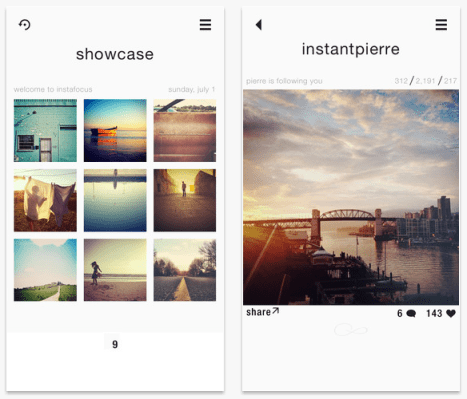Instafocus did what many new app startups did: tried to build a business on the back of another, only slightly older and more stable, one. In this app’s case, that bedrock business was Instagram, which was just testing out its wings as a broad-reaching platform with real-time developer API access. But Instagram changed the rules of the game over Christmas, disabling its real-time API, and that meant rough waters ahead for Instafocus.
Now, the app’s founding team is trying to salvage a tool that struck a chord with users by removing the substrate upon which it was built in the hopes of creating a standalone network that won’t suffer the same fate. Instafocus was originally built as a new filter layer on top of Instagram, with a rotating set of feature photos and galleries hand-picked by editors meant to represent the very best mobile photographers Instagram has to offer.
Instafocus wasn’t originally built on Instagram’s real-time API, but the popularity of the service meant that, pretty quickly, it had to change gears and employ some clever engineering tricks. These involved using that end point, but Instagram decided to shut down that API in response to Christmas demand and hasn’t restored full functionality weeks after making that decision. Instagram is keeping mum on whether it’ll ever actually re-open the real-time API completely, but that isn’t the issue. The issue is that Instafocus built its house on someone else’s land, and that means they’re subject to that other party’s every whim.
To break away, the company has launched a Kickstarter campaign with the aim of separating its product out and going it alone as a contained community. They’re looking for $45,000 to help fund the creation of their own cloud service and social photo-sharing platform. The funds will help them keep the focus on surfacing great content and follow App.net’s example in asking users to pay ($2 per month) in order to guarantee continued access to a service uncluttered by other monetization strategies.
I asked Brandon Shelley, who co-founded pixl3, the studio behind Instafocus, about the company’s strategy in building on Instagram, and what they’ve taken away from that experience.
“Since we originally built Instafocus to augment the Instagram experience anyway, I don’t think we could have started out differently,” Shelley said. “In the end, we learned a lot about being responsible, honest, and concise. Had we started out trying to compete with Instagram – or even had we started out with that goal in mind – I doubt we’d have gained the community support we have.”
The changes to the Instagram API likewise forced their hand. The community is worthy of continued existence, the team feels, but they just can’t practically continue to operate as before. And they believe that there’s a market for what they’re offering that’s very different from the one already served by alternatives like Instagram itself, Facebook, Flickr or even 500px.
“Instagram has such a massive user base now that the photographers have become a minority,” Shelley said. “We’ve always placed good photography first, whereas a lot of the content found in Instagram is based on popularity not quality. Going it alone will affect our product for sure – there will be a lot more people using it. But if you consider our target demographic (mobile photographers in desperate need of a dedicated community), those people will dictate the premise and quality of the app.”
The prospect of a Twitter alternative that wouldn’t sell out managed to rouse enough interest to give Dalton Caldwell’s App.net the crowdfunding boost it needed to ship, but Instafocus is at just a fraction of its goal with only 11 days remaining in the campaign. It’s got a strong grassroots following, but it might be the case that users still aren’t seeing enough good reasons to pay for something they get for free on Instagram yet, especially with that company’s rollback of proposed changes in its terms of service. Still, it’s good to see businesses testing the limits of what consumers will pay for, whether they’re successful or not.
